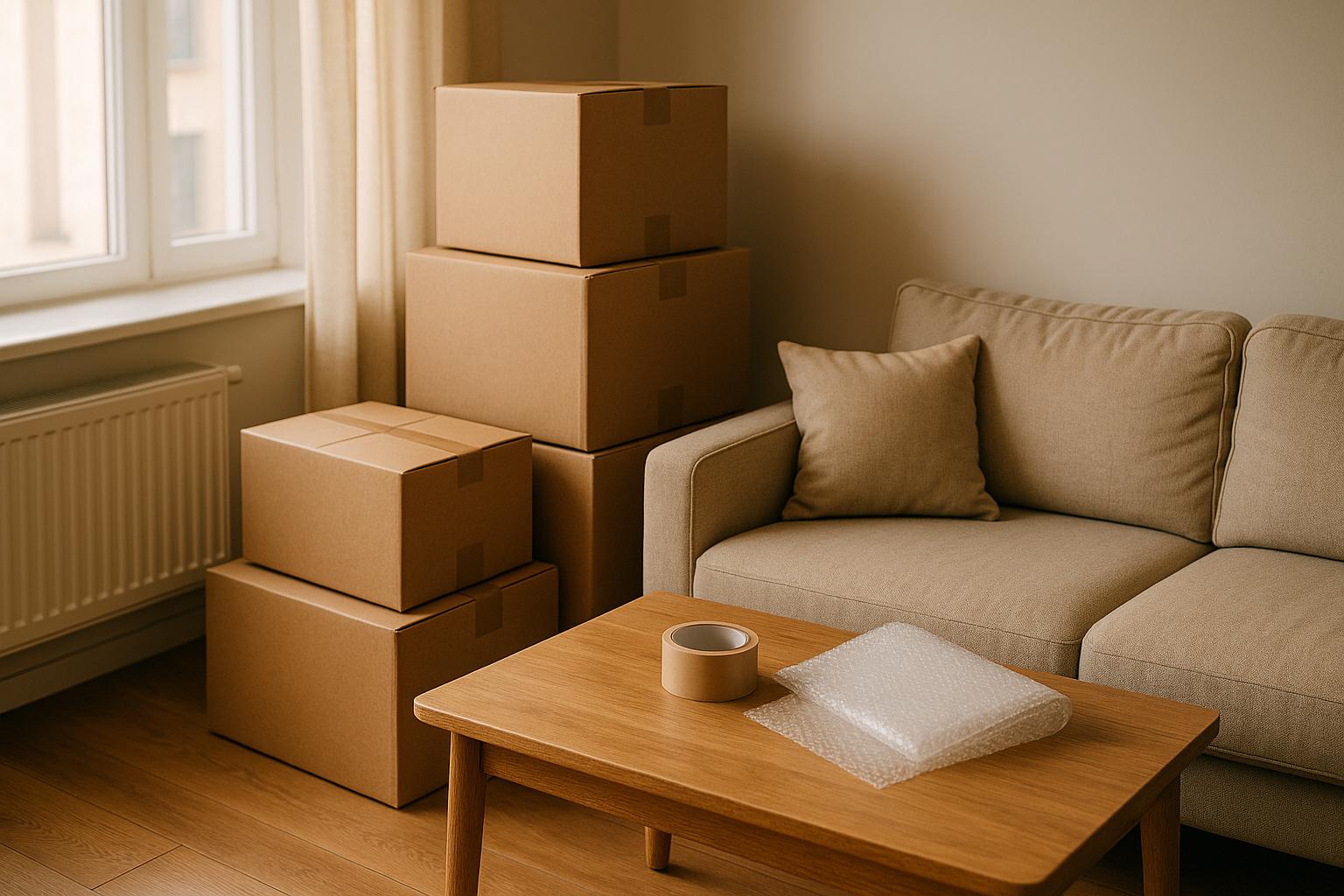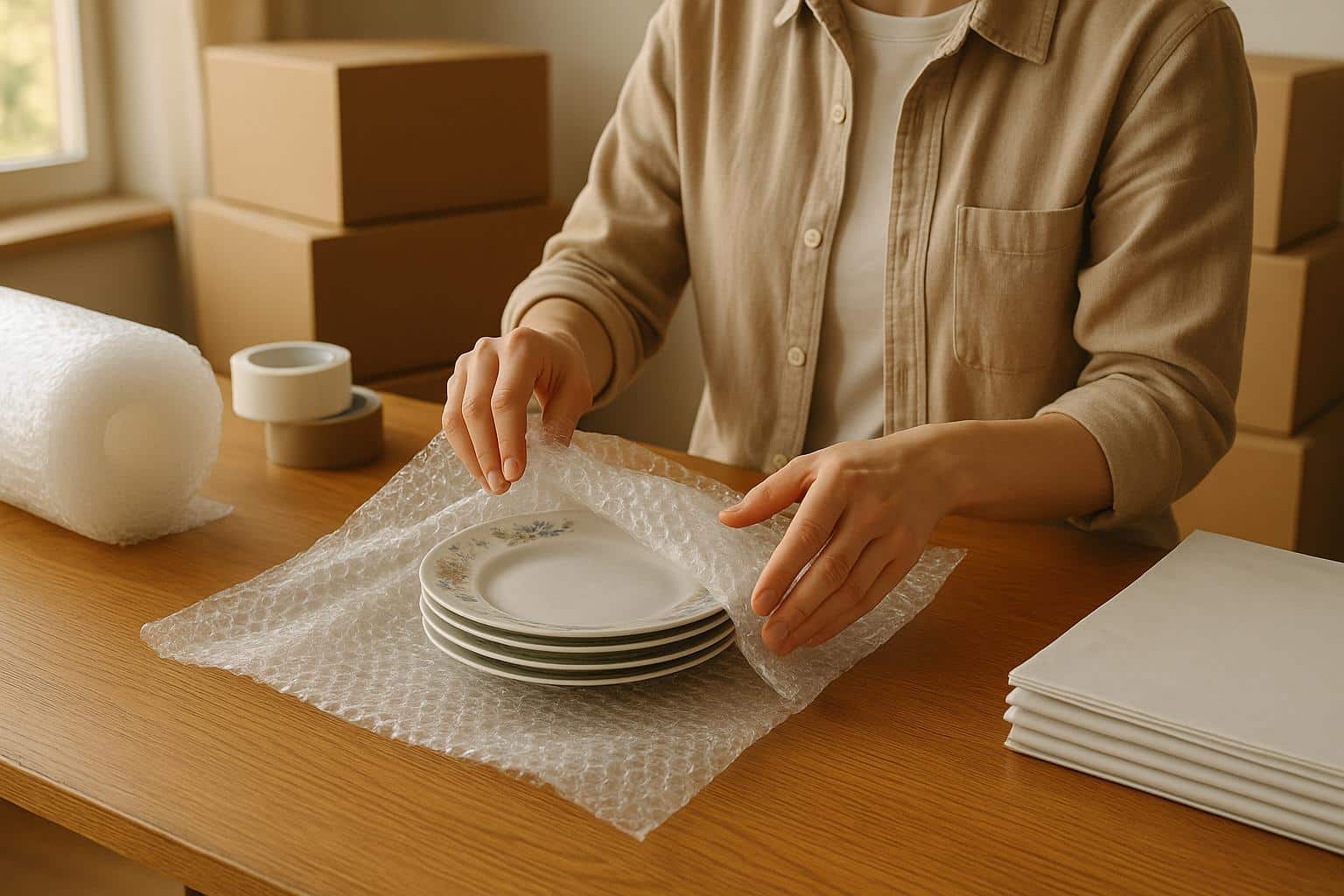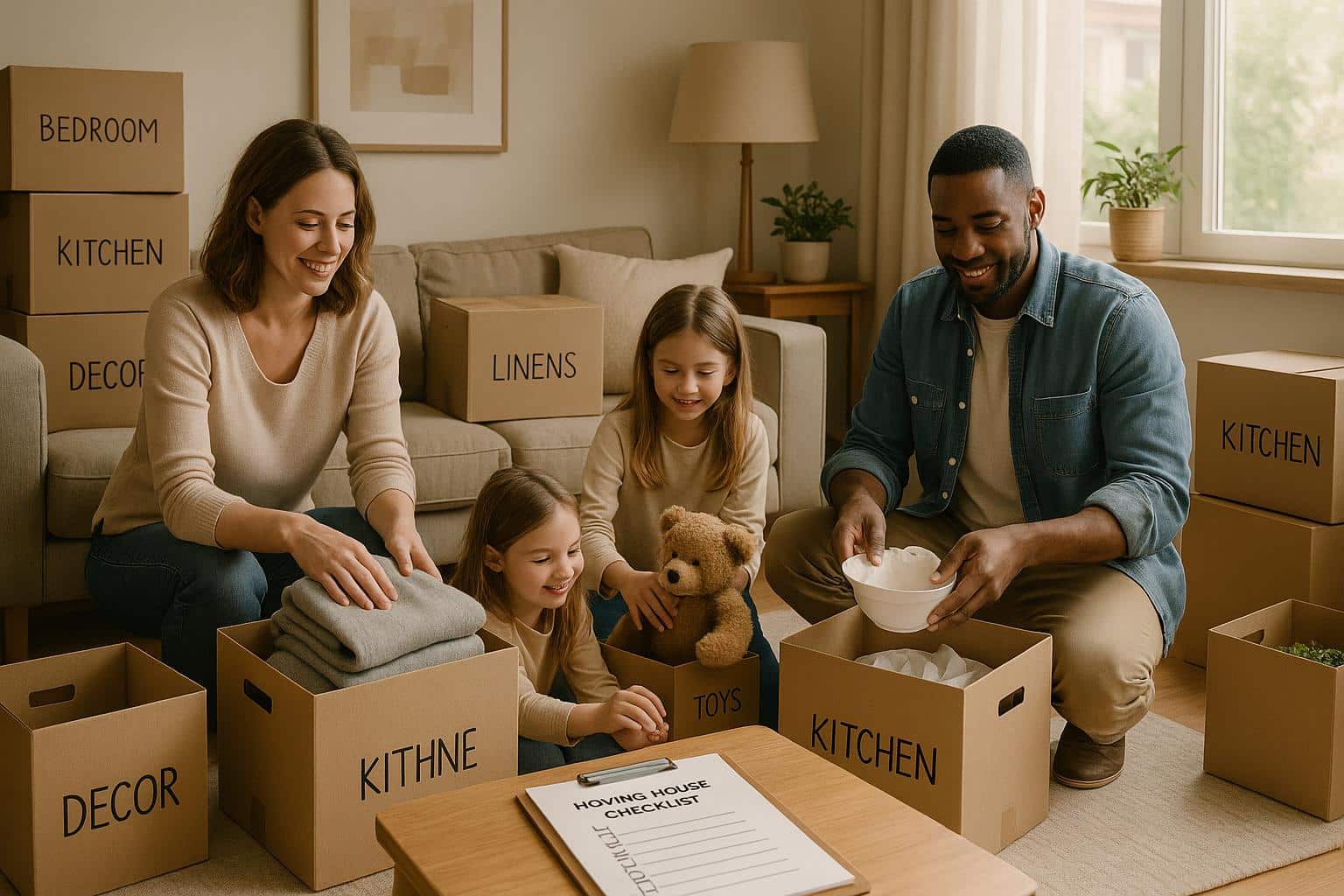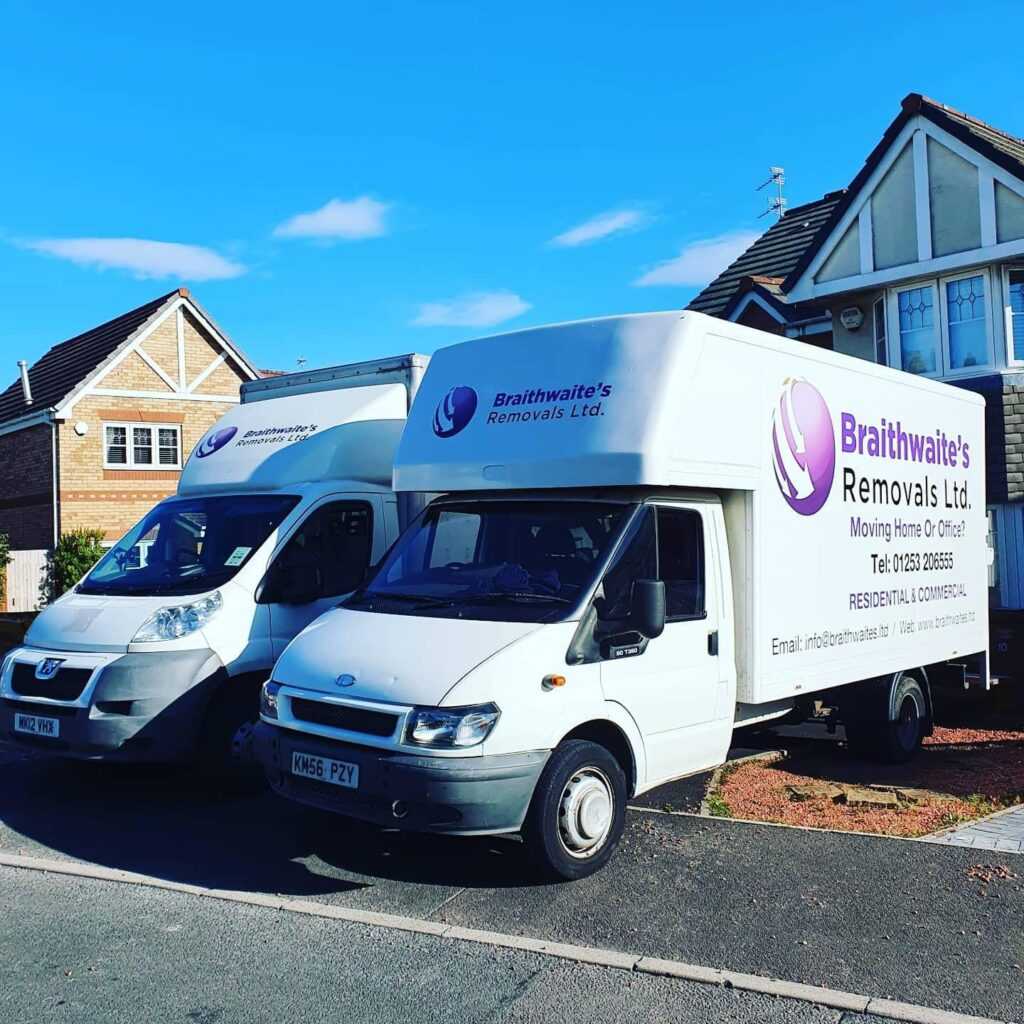When you’re moving house, the materials you choose for packing can make a big difference for the planet. Many conventional options like plastic wrap and bubble wrap harm the environment, but there are greener alternatives available. From biodegradable bubble wrap to recycled cardboard boxes, these materials keep your belongings safe while reducing waste and pollution.
Here’s a quick rundown of 10 eco-friendly packing materials:
- Biodegradable Bubble Wrap: Made from plant-based materials, it protects fragile items and can be composted after use.
- Recycled Cardboard Boxes: Durable, affordable, and recyclable, perfect for packing and storage.
- Compostable Packing Peanuts: Lightweight and shock-absorbing, they decompose naturally in compost.
- Honeycomb Paper Wrap: A flexible paper option for cushioning delicate items.
- Shredded Paper: Simple and cost-effective for filling gaps in boxes.
- Moving Blankets: Reusable fabric covers for protecting large furniture.
- Corrugated Cardboard Sheets: Strong and customisable padding for fragile items.
- Newspaper and Magazine Wrap: A no-cost option for wrapping items or filling voids.
- Paper Tape: A recyclable alternative to plastic tape for sealing boxes.
- Seaweed Packaging: A biodegradable, algae-based material for wrapping fragile goods.
Each of these options offers a way to pack responsibly while keeping your items secure. Whether you’re looking for reusable solutions or materials that break down naturally, these choices let you move house with less impact on the environment.
Key Tip: Many of these materials are available through removal companies like Braithwaite’s Removals Ltd, which focus on greener practices. Consider combining options like recycled cardboard boxes with reusable moving blankets for the best results.
What’s the Most Sustainable Packaging? | Exploring Eco-Friendly Options
1. Biodegradable Bubble Wrap
Biodegradable bubble wrap is a more planet-friendly option, made from plant-based materials like cornstarch, potato starch, or sugarcane. These materials naturally break down into compost without leaving harmful residues behind.
Environmental Benefits
This bubble wrap decomposes when exposed to moisture, oxygen, and microorganisms, making it a safer choice for the environment. Look for certifications like BPI or EN 13432, which confirm that it breaks down without releasing toxins. What’s even better is that it doesn’t compromise on performance, offering both eco-consciousness and durability.
Reliable Protection for Fragile Items
When it comes to protecting fragile items like glassware, ceramics, or electronics, biodegradable bubble wrap holds its own. Its bubble cushioning evenly spreads out impact forces, making it perfect for wrapping delicate or oddly shaped objects like picture frames and ornaments during a move.
Balancing Cost and Moving Efficiency
While it can be a bit more expensive than standard bubble wrap, its lightweight design can actually help reduce overall moving costs. Many professional moving companies now provide eco-friendly packing options, making it easier to go green without breaking the bank.
Reusability and Disposal Options
With careful use, biodegradable bubble wrap can be reused several times. Once it’s no longer usable, you can compost it or dispose of it through local green waste programmes. To maximise its lifespan, keep it stored in a cool, dry place.
2. Recycled Cardboard Boxes
Recycled cardboard boxes are a practical and eco-friendly option, crafted from post-consumer waste that would otherwise be destined for landfill. Not only do they help reduce waste, but they also provide reliable support for moving and storage, making them a smart choice for environmentally conscious individuals.
Green Credentials
These boxes are designed with sustainability in mind. By recycling fibres, the demand for new materials is reduced, which in turn lowers resource consumption and emissions. Certifications such as FSC (Forest Stewardship Council) or PEFC (Programme for the Endorsement of Forest Certification) ensure that they meet strict environmental standards. Once they’ve served their purpose, they can be recycled again or even composted through local systems, making disposal straightforward and responsible.
Protection for Fragile Items
Recycled cardboard boxes, especially double-wall varieties, offer excellent strength and are ideal for transporting a range of items like books, kitchenware, or small appliances. For fragile items, adding extra padding is always a good idea. The corrugated design of these boxes provides natural cushioning, helping to absorb minor shocks during transit and keeping your belongings safe.
Cost-Effectiveness for Moving Needs
One of the standout benefits of recycled cardboard boxes is their affordability. Across many parts of the UK, local councils operate box exchange programmes, where residents can pick up used boxes free of charge. Additionally, community centres and neighbourhood groups often organise box-sharing initiatives, making this option not only budget-friendly but also environmentally sound.
Reusability and Long-Term Use
These boxes aren’t just for one-time use. With proper care, they can be reused multiple times. Store them flat in a dry place to maintain their strength. Later, they can be repurposed for storage, DIY projects, or even as compost material for your garden. To maximise their lifespan, try to minimise damage from tape or other adhesives during use.
3. Compostable Packing Peanuts
Compostable packing peanuts are an eco-friendly alternative to traditional polystyrene foam, offering the same protective qualities while naturally breaking down in composting environments. Made from renewable materials like cornstarch or wheat starch, these peanuts decompose without leaving harmful residues. Let’s dive into their environmental and practical benefits.
Eco-Friendly Benefits
These packing peanuts align perfectly with environmentally conscious moving practices. Made from renewable agricultural resources, they are fully biodegradable. In industrial composters, they decompose within 30–90 days, while in a home compost bin, the process takes around 3–6 months. They meet ASTM D6400 and EN 13432 standards, which confirm their compostable nature and reduced environmental impact.
Reliable Protection for Fragile Items
When it comes to safeguarding delicate items, compostable packing peanuts perform exceptionally well. Their interlocking design distributes weight evenly and absorbs shocks, making them ideal for protecting glassware, ceramics, electronics, and ornaments. They also prevent items from shifting during transit. Plus, their anti-static properties make them a safe choice for packing electronic equipment – all without adding unnecessary weight to your shipment.
Cost Considerations
While compostable packing peanuts may cost more upfront compared to polystyrene options, their benefits often outweigh the price difference. In the UK, a 25-litre bag typically ranges from £15 to £25 and is sufficient for packing several medium-sized boxes. Bulk discounts from suppliers help reduce costs, and since they can be composted, you save on disposal fees – making them a smart investment for eco-conscious movers.
Reusability and End-of-Life Disposal
To maximise their lifespan, store these peanuts in a dry, sealed bag for reuse in future moves or storage. Once they’re no longer needed, simply add them to your compost bin. They’ll break down into organic matter, leaving no harmful residues behind – a win for both you and the planet.
4. Honeycomb Paper Wrap
Honeycomb paper wrap is making waves in the world of sustainable packaging. With its distinctive hexagonal design, this eco-friendly material offers lightweight cushioning while keeping environmental concerns in check. Crafted from recycled paper fibres, it strikes a balance between performance and environmental care.
Environmentally Friendly Choice
This wrap is made from recycled paper, reducing the demand for fresh raw materials and helping to cut down on waste. It’s not just recyclable – it’s also biodegradable under the right composting conditions. Unlike plastic-based alternatives, it steers clear of contributing to the growing issue of microplastic pollution.
Reliable Protection for Fragile Items
The hexagonal structure of honeycomb paper wrap evenly distributes impact, making it a reliable choice for safeguarding delicate items like glassware, picture frames, and electronics. Its flexible nature allows it to conform to various shapes, ensuring items stay cushioned and secure during transit.
A Cost-Effective Packing Option
Available in bulk rolls, honeycomb paper wrap is an economical solution for packing needs. Its efficient design often means less material is required, helping to keep overall packing costs down while still providing excellent protection.
Reusable and Easy to Dispose Of
Durable enough to be reused multiple times, honeycomb paper wrap is a practical choice for those looking to minimise waste. When it’s no longer usable, it can be easily recycled with standard paper waste, requiring no special disposal methods. Keeping it dry ensures it lasts even longer, making it a versatile addition to any packing setup.
5. Shredded Paper
Shredded paper turns everyday office waste into a handy packing material. Whether it’s old documents, newspapers, or magazines run through a shredder, this material provides a simple way to reuse items that might otherwise end up in the bin. It’s a practical solution that ties in perfectly with the eco-conscious practices discussed earlier.
Eco-Friendly Benefits
Shredded paper stands out as one of the most environmentally friendly packing options available. It’s fully biodegradable, meaning it breaks down naturally without leaving any harmful residues behind. On top of that, it’s recyclable through standard household recycling schemes across the UK, making disposal easy and stress-free.
By choosing shredded paper, you’re contributing to a circular waste management system, which helps lower the environmental footprint of your move. Unlike synthetic materials, shredded paper contains no harmful chemicals or additives, making it a safer choice for the planet.
Protection for Fragile Items
Shredded paper offers great cushioning and general protection for items, especially those that are moderately fragile. It moulds to irregular shapes and fills gaps effectively, making it ideal for everyday items that need a bit of extra care.
That said, it’s not the best option for highly delicate items like fine glassware, electronics, or antiques. For these, combining shredded paper with sturdier packing materials is a smart move. It’s also worth noting that shredded paper can settle during transport, so tightly packing your boxes can help maintain consistent cushioning throughout the journey.
Budget-Friendly Packing Solution
In addition to its environmental perks, shredded paper is a highly cost-effective packing option. If you have access to a shredder, you can create it yourself from old documents or unused paperwork. Many offices and businesses are also more than willing to share their shredded paper waste, often at no charge.
Even if you buy pre-shredded paper, it’s still far cheaper than specialised packing materials. A single bag can fill several boxes, making it an economical choice, particularly for large household moves where packing costs can add up quickly.
Reusability and Storage
Shredded paper can be reused multiple times as long as it remains clean and dry. After unpacking, you can gather it up, store it in sealed bags, and keep it for future use.
It compresses easily, so it doesn’t take up much space in storage. Just make sure to keep it away from moisture to maintain its quality. When it’s no longer usable, it can be recycled through standard channels, keeping its eco-friendly cycle going strong.
6. Moving Blankets
Moving blankets offer a practical, reusable way to safeguard furniture and large items during moves. Made from sturdy materials like cotton or recycled polyester, they’re a sustainable alternative to single-use packing options.
Green Credentials
The reusable nature of moving blankets makes them a smarter choice compared to disposable packing materials. Many are crafted from 100% recycled cotton fibres, providing an eco-friendly option that lasts for years. Unlike single-use plastic wraps, these blankets help reduce waste and keep unnecessary materials out of landfills.
Protection Level for Fragile Items
When it comes to shielding large furniture, moving blankets excel. They offer thick padding to prevent scratches, dents, and surface damage on items like wardrobes, dining tables, sofas, and appliances. For the best results, wrap items in multiple layers of the blanket and secure them with packing tape or straps. This ensures everything stays protected during transit.
Cost-Effectiveness for Moving Needs
While the upfront cost of moving blankets might seem higher than disposable options, they pay off in the long run. For example, eco-friendly versions can cost around £4.36 per blanket when purchased in bulk (a 36-pack costs £156.99). Each blanket can replace metres of bubble wrap, plastic sheeting, and cardboard padding, making it a cost-effective choice for multiple moves.
Reusability and Long-Term Use Potential
Moving blankets aren’t just for moving day. They’re versatile enough to be used as workshop protectors, outdoor event covers, emergency tarps, or even shields for storing seasonal items. To keep them in good condition, clean them as per the manufacturer’s instructions and store them in a dry, cool place. Pairing these blankets with reusable items like plastic storage bins can create an even more environmentally conscious moving plan.
sbb-itb-40214c8
7. Corrugated Cardboard Sheets
Corrugated cardboard sheets are a practical and flexible option for keeping your belongings safe during a move. Thanks to their flat design, they can be cut and folded to create custom padding. Whether you’re wrapping artwork, separating fragile dishes, or crafting dividers for boxes, these sheets come in handy.
Environmentally Friendly Choice
Corrugated cardboard sheets are not just useful; they’re also a greener choice. They are widely recyclable and often made with recycled materials. After your move, you can easily recycle them through standard household recycling in the UK. Plus, their biodegradable nature makes them a better disposal option compared to plastic-based alternatives.
Ideal for Fragile Items
The fluted structure of corrugated cardboard creates air pockets that act as a cushion, absorbing shocks and impacts. This makes it excellent for protecting fragile items like mirrors, glassware, and picture frames. For added safety, you can layer the sheets and secure them with paper tape.
Budget-Friendly for Packing
Corrugated sheets are not only effective but also economical. You can cut them to the exact size you need, reducing waste and ensuring a snug fit for your items. This makes them a smart choice for movers looking to save money without compromising on protection.
Durable and Reusable
These sheets are sturdy enough to be reused multiple times. To keep them in good condition, store them flat in a dry place. This way, they’ll be ready for future packing, storage, or even craft projects, making them a long-term, cost-effective solution.
8. Newspaper and Magazine Wrap
After discussing sturdy corrugated cardboard sheets, let’s turn to newspapers and magazines as a clever, no-cost packing option. These everyday items can easily double as protective wrapping. Old newspapers and magazines are not just practical but also an environmentally friendly way to give your belongings a layer of cushioning while reusing materials that might otherwise go to waste.
Eco-Friendly Benefits
When it comes to sustainable packing, newspapers and magazines are hard to beat. Made from biodegradable materials, they naturally decompose over time. Once you’re done unpacking, you can simply toss them into your household recycling bin. Recycling facilities across the UK accept these papers, making them a low-impact choice for the planet.
How Well Do They Protect Fragile Items?
While newspapers and magazines don’t offer the same level of cushioning as bubble wrap, they can still provide decent protection for many items. Wrapping your belongings in several layers creates a soft barrier that helps guard against scratches and minor bumps. They’re particularly effective for books, ornaments, and sturdy kitchen items.
For extra-fragile items like glassware or sentimental pieces, you’ll want to use multiple layers and pair them with other packing materials to keep everything secure.
A Wallet-Friendly Solution
One of the biggest perks of using newspapers and magazines is the cost – or lack of it. If you already have some lying around the house, it’s essentially free. Even if you need to buy a few newspapers, they’re far cheaper than specialised packing supplies. Plus, a single newspaper can go a long way, wrapping multiple items without adding noticeable weight to your boxes. Perfect for those trying to keep moving expenses in check.
Can They Be Reused?
While newspapers and magazines might not hold up for multiple moves due to tearing or crumpling, they’re far from single-use items. After you’ve unpacked, they can be repurposed for tasks like cleaning windows, lining drawers, or even gardening projects like composting or weed control. Their versatility ensures they stay useful long after their job as packing material is done.
9. Paper Tape
Paper tape is gaining popularity as an environmentally friendly alternative to traditional plastic tape. Made from paper fibres and featuring water-based adhesives, it’s a practical and eco-conscious choice for sealing moving boxes.
Environmental Benefits
Paper tape stands out for its environmental advantages. It’s biodegradable, breaking down far quicker than plastic tape, and its water-based adhesive is typically free from harsh chemicals, making it safer for both you and the planet. Plus, since it’s made from recyclable materials, you can often leave it on cardboard boxes when recycling, simplifying the process. This makes it a solid choice for those looking to reduce their environmental footprint.
Cost and Efficiency
While paper tape might cost a little more upfront than plastic tape, it often proves more efficient. Its strong adhesion means you’ll use less tape to get the job done, which helps preserve your boxes for reuse and cuts down on mess when unpacking.
Durability for Fragile Items
Paper tape provides dependable sealing strength during transport, even when boxes are shuffled or stacked. For the best results, apply it to clean, dry surfaces to ensure a secure bond.
Reuse and Disposal
Although paper tape isn’t designed for reuse, it allows your boxes to remain intact for repurposing. Any leftover tape can often be composted, making it an excellent choice for those aiming to stick to sustainable practices.
10. Seaweed Packaging
Let’s dive into another eco-conscious packing option: seaweed packaging. Like biodegradable bubble wrap and compostable packing peanuts, this natural alternative aims to minimise long-term waste while offering a greener solution for packing needs.
Seaweed packaging is crafted from marine algae, providing a biodegradable substitute for traditional plastic-based materials. It comes in various forms, including flexible films and sturdy containers, making it versatile for different packing requirements.
Eco-Friendly Benefits
Seaweed packaging stands out for its biodegradable nature and its reliance on fast-growing seaweed, which doesn’t compete with food crops. This makes it an appealing alternative to conventional plastics, with the added bonus of potentially reducing its carbon footprint through the natural growth process of seaweed.
Suitability for Fragile Items
Despite its natural origins, seaweed packaging can be tailored to protect delicate items effectively. It can be manufactured in different thicknesses, offering cushioning and the flexibility to wrap around irregularly shaped objects. This makes it particularly useful for safeguarding fragile items like glassware, ornaments, or electronics. Just remember to keep it dry until you’re ready to use it for the best results.
Cost Considerations
As a relatively new innovation, seaweed packaging tends to be pricier than traditional options due to limited production and advanced manufacturing processes. However, its environmental advantages often outweigh the cost, especially when used for high-value or sentimental items. Many users combine it with other sustainable materials to balance cost and functionality.
A One-Time, Waste-Free Option
Designed to be a single-use solution, seaweed packaging naturally decomposes after use, reducing waste and environmental harm. This makes it ideal for unpacking items that are immediately needed upon arrival, ensuring minimal leftover material to manage.
Material Comparison Table
Here’s a handy table summarising the key features of various eco-friendly packing materials. It highlights factors like environmental impact, protection, cost, and reusability, making it easier to choose the best option for your move.
| Material | Eco-Friendliness | Protection Level | Cost | Reusability |
|---|---|---|---|---|
| Biodegradable Bubble Wrap | Excellent – fully compostable | High – strong cushioning | High | Single Use |
| Recycled Cardboard Boxes | Very Good – made from waste paper | Medium – structural protection | Low | Reusable for multiple moves |
| Compostable Packing Peanuts | Excellent – biodegradable | High – great for void filling | Moderate | Single Use |
| Honeycomb Paper Wrap | Very Good – recyclable | High – flexible cushioning | Moderate | Limited Reusability |
| Shredded Paper | Good – repurposed material | Low – basic void fill | Very Low | Single Use |
| Moving Blankets | Good – durable fabric | Very High – heavy-duty protection | High | Highly Reusable |
| Corrugated Cardboard Sheets | Very Good – recyclable | Medium – surface protection | Low | Moderately Reusable |
| Newspaper Wrap | Good – repurposed material | Low – suitable for light items | Very Low | Single Use |
| Paper Tape | Very Good – recyclable adhesive | N/A – sealing only | Moderate | Single Use |
| Seaweed Packaging | Excellent – marine biodegradable | Medium – moderate cushioning | Very High | Single Use |
This comparison highlights ways to reduce environmental impact while keeping your move safe and cost-effective.
For long-term use, moving blankets stand out due to their durability. Recycled cardboard boxes offer a practical mix of affordability and sustainability, making them a popular choice. If you’re packing fragile items, biodegradable bubble wrap and compostable packing peanuts provide excellent cushioning, though they tend to be pricier.
Budget-conscious movers might prefer options like shredded paper, newspaper wrap, or recycled cardboard boxes, which are economical and eco-friendly. For those prioritising sustainability, materials with strong environmental credentials, such as seaweed packaging, may be worth the higher cost.
Final Thoughts
Opting for eco-friendly packing materials not only helps reduce waste but also ensures your belongings are well-protected during a move. The ten sustainable options discussed here show that it’s entirely possible to safeguard both your items and the planet at the same time.
Unlike conventional plastics, these alternatives decompose much faster under the right conditions. And they don’t compromise on performance – moving blankets provide excellent cushioning for furniture, while recycled cardboard boxes are sturdy and environmentally responsible. The trick is to match the material to the specific protection needs of your items.
Sustainable packing doesn’t have to break the bank either. Many of these materials are reusable, making them a smart investment for future moves. Plus, with growing consumer interest, suppliers now offer more biodegradable options than ever, making eco-friendly moving both practical and accessible.
Thoughtful packing choices not only make the moving process smoother but also contribute to a healthier planet. If you’re looking for expert guidance, consider working with a removal company that prioritises quality and sustainability. For example, Braithwaite’s Removals Ltd provides comprehensive packing services and can recommend eco-friendly solutions tailored to your needs.
Switching to sustainable packing is a small change that makes a big difference. Every recycled box, biodegradable wrap, and reusable blanket helps pave the way for a greener future – all while keeping your belongings secure during the move.
FAQs
Are eco-friendly packing materials more expensive than traditional options?
The price of eco-friendly packing materials can differ based on the type and supplier. Some options, like recycled cardboard boxes, are often reasonably priced, while others, such as biodegradable bubble wrap or compostable packing peanuts, might cost more due to the specialised materials and production methods required.
That said, using eco-friendly packing materials can be a smart choice, as they minimise environmental harm while still providing reliable durability and protection for your items. To save money, try reusing packing supplies when possible or buying sustainable materials in bulk.
How can I be sure the eco-friendly packing materials I choose are truly sustainable and reliable?
To make sure your eco-friendly packing materials are truly sustainable and dependable, keep an eye out for well-known certifications like FSC (Forest Stewardship Council), which ensures wood and paper products are responsibly sourced, or Cradle to Cradle, which focuses on materials designed with sustainability at their core. These certifications guarantee the materials adhere to strict environmental standards.
You should also look for symbols that indicate whether the materials are recyclable, compostable, or made from recycled content. Great options include recycled cardboard boxes, biodegradable bubble wrap, and compostable packing peanuts – practical for moving and much gentler on the planet. By selecting certified and clearly labelled materials, you can pack responsibly while helping to minimise your environmental footprint.
How can I make eco-friendly packing materials last longer during a move?
When moving, extending the life of eco-friendly packing materials is easier than you might think. Start by using multi-purpose items like towels, blankets, or old clothes to cushion your belongings. These can be washed and reused, making them a practical and waste-free solution.
Choose durable, reusable materials such as sturdy plastic bins or high-quality cardboard boxes that can handle multiple moves without falling apart. Steer clear of single-use options and instead go for sustainable choices like biodegradable packing peanuts or recyclable packing tape.
Once your move is complete, don’t toss out items like bubble wrap or boxes. Store them for future use or pass them along to friends or community groups who might need them. These small, thoughtful steps can make a big difference in cutting down waste and supporting a greener lifestyle.





